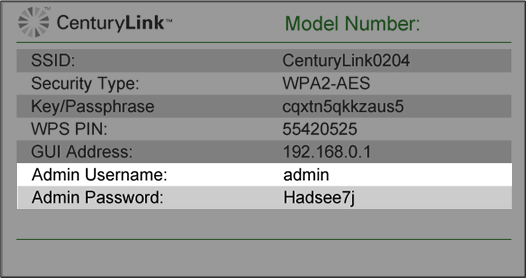Configure WAN settings on your CenturyLink modem
WAN settings allow you to change the protocol and addressing type required by CenturyLink for internet access.
Do not change these modem settings unless instructed by a CenturyLink technician or working with an IT professional.
Note: Your modem settings may appear slightly different from the images below, but the steps will be the same.
These instructions are for newer CenturyLink modems. If you have an older modem, follow these instructions.
Access the WAN settings
There are a few types that can be set up, but all configuration types will begin with the same 5 steps below.
1. Connect a device to your network over WiFi or using an Ethernet cable connected to your modem. This works best on a tablet or computer.
2. Open a web browser and type http://192.168.0.1 into the web address field.

3. Sign in to the modem settings (GUI) using your Admin Username and Admin Password, printed on the sticker.

4. Select Advanced Setup in the main menu.

5. Select WAN Settings in the left sidebar. This menu option may appear beneath the WAN Settings section, or the IP Addressing section, depending on your modem model.

Choose your setup type
A PPP connection is used by some providers to deliver your internet. The DSL light on the modem should be solid green, indicating an active network connection, before configuring this setting.
After following steps 1-5 above to access your modem's WAN settings, continue with step 6:
6. Select PPPoE for the ISP Protocol.

7. Enter the PPP username and password details:
- Enter your PPP username.
- Enter your PPP password.
- Enter the password again to confirm.
- Select "Enable" for "PPP Auto Connect."
- Select "Disable" for "No PPP Credentials."

Note: If you don't know your PPP username or password, chat with tech support.
From here, most customers will follow steps 8-10 below and choose dynamic IP in step 8.
8. For the IP Addressing Type, select either Dynamic IP if you have a dynamic IP address (true for most customers) OR Single Static IP and then the single static IP address you are leasing.

9. Select Dynamic DNS for the DNS type.

10. Select Apply to save your changes.

These steps apply only if you have leased a block of IP addresses and want a private or a public LAN (local area network) Subnet.
- The Private LAN Subnet tells the modem to assign all devices on the network a private LAN IP address (e.g. 192.168.0.4). The exception is for any device that has the TCP/IP settings manually configured with an "assignable" WAN IP address from your block.
- The Public LAN Subnet option tells the modem to assign all devices on the network an assignable WAN IP address from your block of leased addresses.
Complete steps 1-7 above.
8. Enter the IP addressing details:
- Select Block of Static IP Addresses for the IP Addressing Type.
- Enter the Gateway Address that was provided to you when you leased your static IP addresses.
- Enter the Subnet Mask that was provided to you when you leased your static IP addresses.
- Select either Private LAN Subnet or Public LAN Subnet for LAN DHCP Addressing.

9. Enter the DNS details:
- Select Static DNS for the DNS type.
- Enter your Primary and Secondary DNS (DNS lookup).

10. Select Apply to save your changes.

The DSL light on the modem should be solid green, indicating an active network connection, before configuring this setting.
After following steps 1-5 above to access your modem's WAN settings, continue with step 6:
6. Select IPoE for the ISP Protocol.

7. Select Dynamic or Static IP for the IP Addressing Type.

7b. For Static IP only, enter your IP address, subnet mask, and gateway address.

8. For dynamic IP, select Dynamic DNS. For static IP, select Static DNS. Enter the primary and secondary DNS for your area.

9. Select Apply to save your changes.

The DSL light on the modem should be solid green, indicating an active network connection, before configuring this setting.
After following steps 1-5 above to access your modem's WAN settings, continue with step 6:
6. Select Transparent Bridging for the ISP Protocol.

7. Chat with tech support to get the transport mode (VLAN Setting) that works in your area (not available in all areas).

8. Select Apply to save your changes.

Top Tools
Was this information helpful?
Support topics





.png)





